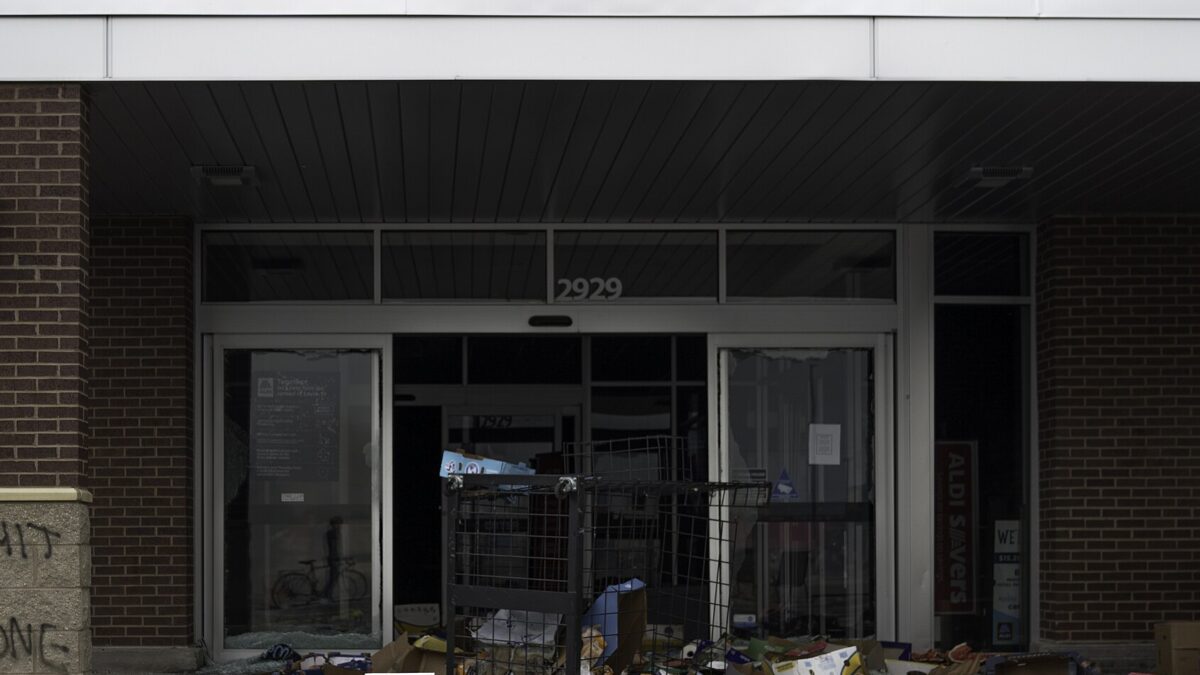
The world witnessed in the streets of Minneapolis this spring and summer the feature presentation after many increasingly violent coming attractions, created, produced, and distributed by a one-party, radical left government.
If you want to know what the real-time self-destruction of a city looks like, Minneapolis offers the perfect model. This is no Detroit-esque collapse prompted by the degeneration of an industry-dependent metropolis. This is the willful push down the path of ruin of a city burgeoning with opportunity and rife with promises of the American Dream. It is suicide.
Downtown’s ghost-town feel is taking a dystopian turn as empty streets are being taken over by a resurging homeless population openly using drugs and increasingly aggressive. The mentally ill are left to similar fates, often found huddled in bus shelters.
A decline in police and mental health resources compounds the impending disaster as winter deepens and shelters fill. This is a city in which some of the most recognizable companies make their national and regional headquarters: Target, General Mills, Wells Fargo, U.S. Bank, and Xcel Energy. They have the resources to ride out the lockdowns, but the corner hot-dog stand, skyway mini-mart, and corner bar likely don’t.
The disease plaguing the streets of Minneapolis’ north side and the areas around Chicago Avenue and Lake Street is less about COVID and more about the consequences of what Fyodor Dostoyevsky asks of man in “Notes from the Underground,” “But why has he such a passionate love for destruction and chaos?” For a far-left Minneapolis City Council at war with its police force and local citizens yet maintaining control due to leftist activism and special interests, the answer may be in the blind devotion to the radical belief of constantly burning and building into the unattainable utopia they so hubristically believe they can create.
This idea has been building for some time. After Jamar Clark was killed by police in Minneapolis in November 2015, three weeks of protests ensued, including a freeway shut-down, rallies, and sit-ins at City Hall and the Fourth Precinct police station.
These were organized by the newly formed group Twin Cities Coalition for Justice 4 Jamar (TCCJ4J), an organization connected with the National Alliance Against Racist and Political Repression (NAARPR), a Marxist group allied with Angela Davis and the Black Lives Matter organization. They culminated in the resignation of MPD Chief Janeé Harteau at the request of the Democratic Party mayor of Minneapolis, Betsy Hodges, in 2017.
Any lessons that could have been learned were repeatedly and effectively dismissed by civic leaders, government officials, and radical counter-community groups as insufficient to counter what they believe is an inherently racist system. City government, which is wholly controlled by Democrats, simply moved the deck chairs on this sinking ship at the behest of radical groups using intimidation tactics to encourage not justice and reform, but to disband the police department.
As the leadership vacuum in the city erased fortitude in the name of justice, violent rioters, looters, and opportunists sought their fortunes amid the helpless businesses in their paths. Minneapolis Mayor Jacob Frey sacrificed the Police Third Precinct building, let the roving mob reduce the city to a smoldering pile of ashes, then engaged the equally inept governor in a game of finger-pointing to evade his responsibility to a community suffering from shell-shock.
Although seemingly improbable, the situation in Minneapolis has declined since the riots, at least for the citizens held hostage by the smug arrogance of the people charged with acting in their best interest. The city earned the nickname “Murdereapolis” during its crime spike in the mid-‘90s. Instead of looking to successful policies used to counter that crime wave—increasing the number and presence of law enforcement officers for several months—the Minneapolis City Council wants to do the exact opposite.
In June, the council forwarded a proposal to the city’s charter commission to give voters a chance to eliminate the funding requirement for the police department. That proposal would have allowed the city to defund and dismantle the police and create a new Community Safety and Violence Prevention department. The commission tabled the proposal for a later date.
Meanwhile, homicides in Minneapolis reached 77 on just one day this month and a murder rate, according to AH Datalytics, up more than 78 percent relative to 2019. Violent crime is also at record levels, and property crime, robberies, theft, and carjackings have all increased substantially as well.
Final national murder update of 2020:
Murder up 36.7% in 57 agencies with data through at least September (though most have data through November). Murder up in 51 of 57, 37 of 58 agencies reporting murder up more than 30%.
Spreadsheet here: https://t.co/vEhKHuFNrY pic.twitter.com/5HgVmwGmDS
— Jeff Asher (@Crimealytics) December 29, 2020
Despite pleas from citizens held captive in their own homes and speaking out through community groups like Lisa Clemons’s A Mother’s Love Initiative, the radicals on the City Council use race to perpetuate a culture of victimhood to advance their agenda, instead of finding ways to work with community groups and the police to solve problems. Now, eight residents are suing the City Council and Frey, arguing they violated the city charter’s requirement to staff approximately 743 officers for the 425,000-person city.
Since May, roughly 150 of approximately 800 MPD officers have quit, retired, or taken disability or personal leaves. The shortage prompted Police Chief Medaria Arradondo to request hiring officers from other jurisdictions. He met skepticism and a severe budget shortfall that ironically has resulted in the City of Minneapolis paying officers to retire.
To add to the frustration of a city desperate for an end to the chaos and for leaders to increase public safety and heal the city, in an Orwellian-named “Safety for All Budget Plan” the council cut $8 million from the mayor’s 2021 police budget.
The mayor had proposed 888 officers, a number already reduced by the city’s budget woes, but the city only funded an average of 770 officers for 2021. For a city in crisis, this makes as much sense as trying to put out a fire with a can of gasoline. The only thing this plan will extinguish is any hope for the people left suffering daily violence in their neighborhoods.
A city reeling from a summer of chaos and violence and serving as a laboratory for radical, power-mongering autocrats is a case study in how a city commits suicide. Just don’t phone the police. There might not be anyone to answer the call.









